In the Philippine B2B landscape, reverse auctions are reshaping e-procurement strategies. This approach allows buyers to secure competitive pricing while giving suppliers a transparent platform to compete. By simplifying procurement workflows and reducing costs, reverse auctions are becoming a key tool for businesses. They also level the playing field for SMEs, enabling them to compete effectively with larger companies. Industries such as retail, healthcare, automotive, manufacturing, and construction are increasingly adopting reverse auctions to improve efficiency and maintain a competitive edge.
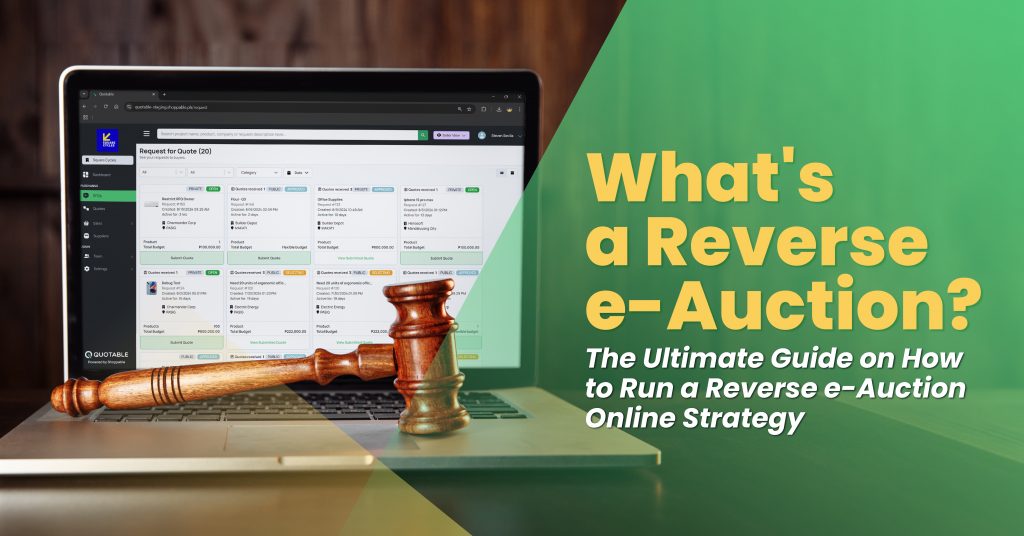
What is a Reverse e-Auction?
In a reverse auction, sellers compete by lowering their prices to win the business, unlike a traditional auction where buyers place increasing bids to purchase an item. Instead of buyers bidding up the price, sellers continually reduce their offers until the buyer chooses the most favorable deal.
Other Terms for Reverse Auction
- e-Procurement
- Procurement Auction
- Purchasing Auction
- Sourcing event
- B2B Auction
How does Reverse e-Auction Work?
In a reverse auction, a buyer requests a product or service and invites sellers to bid at their lowest prices. The seller who offers the lowest bid and meets the terms wins the contract. Online auction platforms have made reverse auctions more popular by allowing sellers to compete in real time. Today, this method is widely used by big companies, government agencies, and businesses in the Philippines to buy everything from raw materials to services like accounting and business process outsourcing (BPO) support.
Benefits of Reverse e-Auction to Buyers
Instead of having buyers compete to purchase products, a reverse auction allows sellers to place bids to offer their goods or services. For buyers, this method provides several advantages:
- Wholesale Pricing: As sellers compete for the buyer’s business, competitive bidding often results in lower prices and more favorable deals.
- Faster Procurement: The auction format speeds up the process by allowing buyers to quickly compare offers, reducing the time spent researching options.
- Timely Deliveries: Auctions typically have set deadlines, which helps ensure that sellers meet delivery schedules and production timelines.
Benefits of Reverse e-Auction to Sellers
From broadening market access to simplifying the bidding process, and establishing better payment terms, reverse e-auctions can provide valuable opportunities and efficiencies for sellers.
- Broader Buyer Access: Online reverse auctions enable sellers to bid on projects from buyers worldwide, expanding their market reach beyond local or regional limitations.
- Equal Information for All: Every seller receives the same request for proposal (RFP) and information, ensuring transparency and a fair competitive environment.
- Opportunities for Small Businesses: Unlike traditional procurement methods that might favor larger firms with established contacts, reverse auctions level the playing field, giving smaller companies a fair chance to compete.
- Simplified Workflow: The fast-paced nature of reverse auctions saves time for both sellers and buyers, allowing sellers to focus on other opportunities and activities.
- Transparent Payment Terms: Buyers outline their needs upfront in the auction, reducing ambiguity and streamlining the process by providing sellers with a clear understanding of what is required.
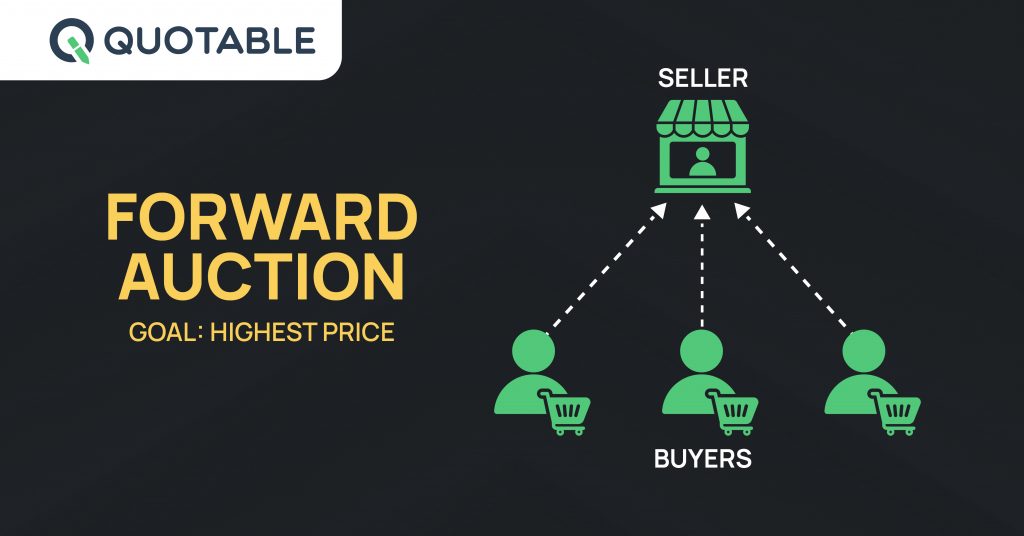
Price Drive Differentiation
What is a Forward Auction?
A Traditional Auction, often called “Standard Auction” or “Forward Auction,” is where buyers compete by offering higher bids, which causes the price to rise. Before they start bidding, buyers usually research the product thoroughly to understand its value. The auction continues as long as buyers keep placing higher bids, driving the price up based on how much interest and competition there is.
- Forward auctions are best used for collectible items, artwork, luxury goods, cars, jewelry, real estate, 2nd hand goods, rare items, and unique services.
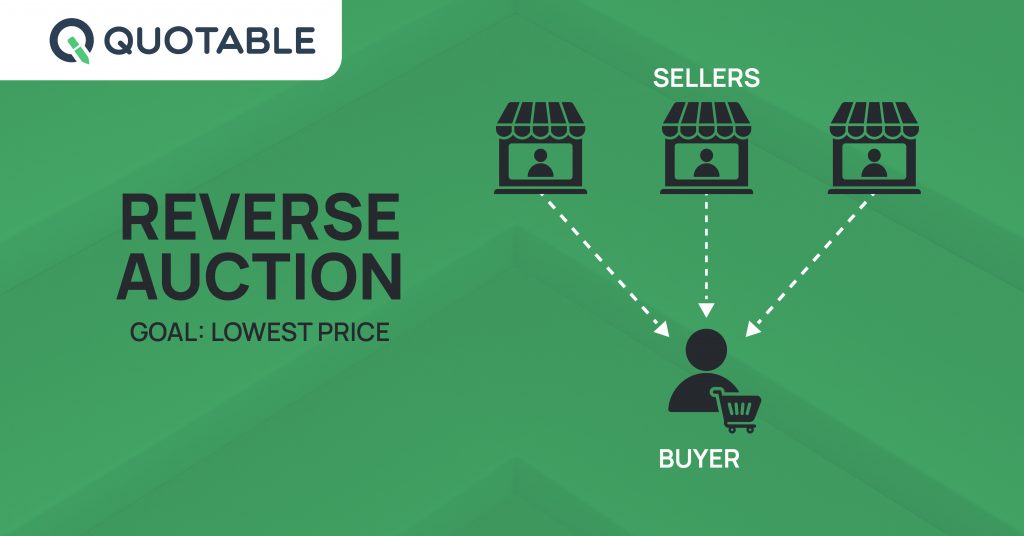
What is a Reverse Auction?
During a reverse auction, sellers compete by offering progressively lower prices for their products or services, which brings the final price down. Rather than buyers increasing their bids, sellers aim to make their offers more attractive by highlighting their benefits, striving to stand out and offer the best value.
- In a reverse auction, sellers actively pursue buyers to offer their products or services, especially since these transactions often involve bulk orders.
Examples of Reverse e-Auctions
While a reverse auction may not fit every industry, it can be highly effective in certain contexts within the Philippines or internationally. Here are some examples:
Government Contracts
In the Philippines, reverse auctions are frequently used by government agencies, such as the Department of Public Works and Highways (DPWH), which procure goods and services related to infrastructure projects. For instance, when the DPWH needs to source materials or services for road construction or other public works, they might conduct a reverse auction to gather competitive bids from suppliers.
Manufacturers
Manufacturers frequently utilize reverse auctions to source their suppliers efficiently. For instance, if a solar distributor in the Philippines needs to procure solar panels for a project, it might conduct a reverse auction. Panel manufacturers would submit bids to provide the panels, competing to offer the best price and terms. This process helps the solar company secure competitive pricing and simplify its procurement by evaluating multiple offers in a structured and transparent manner.
Types of Reverse Auctions in Procurement
What is a Ranked Reverse Auction?
The Ranked Reverse Auction is a popular method where buyers use platforms and suppliers submit bids that are often close to one another in price range and specifications. The selection of the winning supplier is based not solely on the lowest bid but also on additional criteria such as product quality and delivery time.
This approach allows buyers to conduct a comprehensive evaluation, ensuring that the final choice is well-rounded and meets all essential requirements. Although suppliers ranked lower may perceive limited chances of winning, the transparent criteria used in this auction type help ensure that the most suitable supplier is chosen.
What is an Open or English Reverse Auction?
The English Reverse Auction is commonly employed for commodity procurement. It begins with the buyer setting a high initial price, which then decreases gradually. Suppliers are invited to submit lower bids as the price drops, provided their offer improves upon the current lowest bid.
This auction format allows buyers to secure competitive pricing while also considering other critical factors such as product quality. It offers a structured process for negotiating deals and obtaining the best value through competitive bidding.
What is a Japanese Reverse Auction?
The Japanese reverse auction is characterized by its unique pricing adjustment mechanism. Buyers start with an initial price, and suppliers can choose to accept or reject this price. If multiple suppliers accept, the buyer may lower the price incrementally throughout the auction.
This process continues until only one supplier remains. The Japanese reverse auction facilitates dynamic pricing and fosters competition among suppliers, allowing buyers to obtain the best possible deal through iterative price reductions.
What is a Dutch Reverse Auction?
The Dutch reverse auction involves buyers specifying their requirements for price, quantity, and terms upfront. Suppliers who can meet these specifications then submit their bids. This auction type is effective in ensuring a faster procurement process, particularly for purchasing raw materials, food products, IT services, and medical supplies.
By allowing suppliers to bid competitively based on defined criteria, the Dutch reverse auction helps both buyers and suppliers achieve favorable terms and improve their procurement process.
Reverse e-Auction Procurement Strategy
Work with a Variety of Suppliers
Bring in a wide range of suppliers to join the auction. More bidders mean more competition, which helps you get better deals.
Set Clear Requirements
Clearly describe what you need in terms of cost, quality, and other important factors. This ensures that all suppliers are competing on the same terms, making it easier to compare their offers.
Be Transparent
Explain the auction terms, your procurement process, and your company’s values. Being open and clear helps build trust with suppliers and sets clear expectations.
Check Supplier Qualifications
Make sure each supplier meets your standards and can deliver what they promise. This ensures you’re working with vetted suppliers.
Gather Supplier Information
Collect detailed information about potential suppliers to make informed decisions. Knowing their capabilities and past transactions helps you choose the best fit.
Use E-Procurement Tools
Use e-procurement software to track the auction in real time. One of the best platforms you can try is Quotable. It’s an end-to-end supply chain workflow solution that helps you manage bids, compare quotes, negotiate terms, add approvers, and centralize your overall procurement workflow.
NOTE: E-auction on Quotable is currently being built and will be available soon!
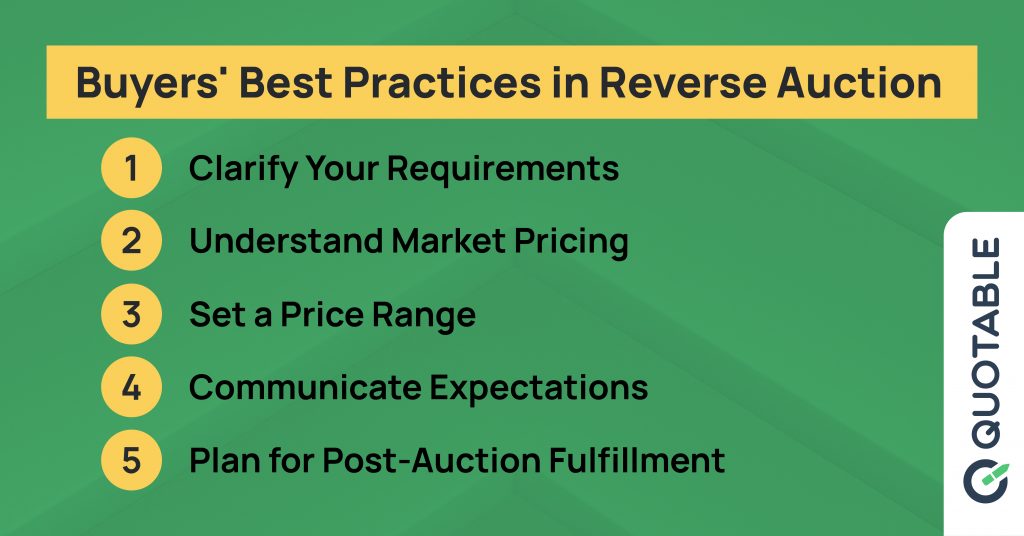
1. Clarify Your Requirements
Ensure that your Request for Proposal (RFP) clearly outlines your business needs.
Detailed specifications help suppliers provide accurate bids and reduce the chances of miscommunication.
2. Understand Market Pricing
Have a solid grasp of current market rates for the goods or services you’re procuring. This knowledge enables you to spot competitive bids and avoid overpriced offers.
3. Set a Price Range
Begin the auction with a price that reflects or slightly exceeds the current market value. This approach encourages sellers to participate, knowing they have a fair starting point. As the auction progresses, sellers will compete to offer the lowest price they are willing to sell for. By starting at or above market rates, you ensure that sellers are motivated to bid down, ultimately securing the best possible deal for your business.
4. Communicate Expectations
Provide clear guidance on your evaluation criteria and how you’ll assess bids.
Transparency in your expectations will encourage more relevant and competitive offers.
5. Plan for Post-Auction
Once the auction concludes, focus on clear communication regarding payment timelines, delivery schedules, and fulfillment expectations. With the best price already secured during the auction, ensure that all terms are aligned to facilitate timely delivery and smooth transaction execution.
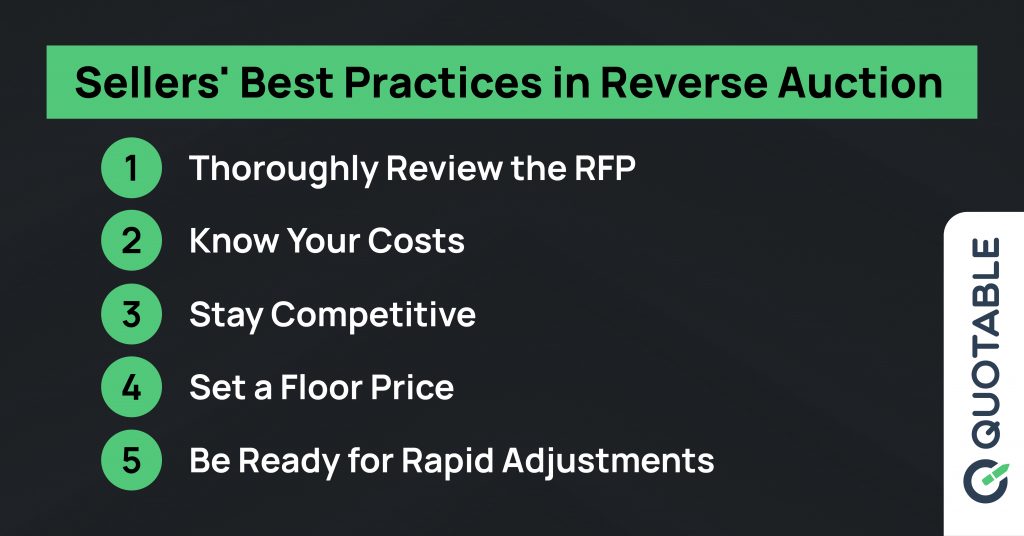
1. Thoroughly Review the RFP (Request for Proposal)
Understand the buyer’s needs inside and out. A thorough review of the Request for Proposal (RFP) helps you tailor your bid to meet specific requirements, increasing your chances of success.
2. Know Your Costs
Ensure you’re aware of your production and delivery costs before placing your bid. Knowing your numbers will help you avoid making offers that aren’t financially viable.
3. Stay Competitive
Keep an eye on the market and your competitors during the auction. Remaining competitive is crucial to securing the deal without undercutting your profit margins.
4. Set a Floor Price
Decide on the lowest price you’re willing to bid before the auction begins. This ensures that you maintain profitability, even in a competitive bidding environment.
5. Be Ready for Rapid Adjustments
Auctions can move quickly, so be prepared to adjust your bid in real time. Flexibility and quick decision-making can give you an edge in winning the contract.
Key Takeaways
As highlighted in this article, reverse auctions can be a strategic advantage for B2B procurement, especially in scenarios where cost competitiveness and a wide range of suppliers are involved. They deliver substantial savings in both time and expense, significantly improving procurement efficiency.
However, it’s important to balance cost with quality. Ensure detailed contract specifications are in place to uphold high standards. Sometimes, paying a bit more for superior quality and faster workflow can provide better long-term value, sales, and performance.
To make your procurement process more efficient, explore Shoppable’s latest tool, Quotable, a FREE software designed for MSMEs in the Philippines that helps modernize procurement workflows.
You can learn more about how Quotable can support your business by visiting:
